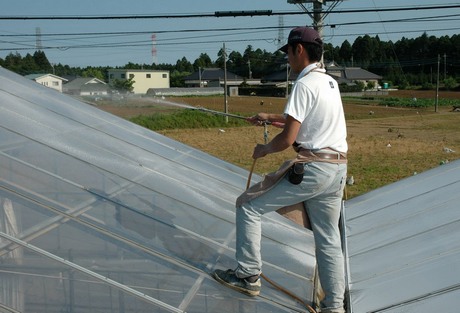
The French company Sudlac is a manufacturer and developer of horticultural coatings. The company has a long standing history in the manufacturing of paints that dates back to 1959 when it all started with building paints and linemarking paint for sport fields. Over the years the company evolved to an important player on the market for horticultural shading agents. According to Sudlac's export manager Jorien Schouten, the company spends a lot on R&D to meet the grower's rising demand for advanced shading materials. "Much has changed over the last years", she said. "In the past you mainly used paint to protect the crop from too much light. Nowadays we can do the opposite; reduce the temperature but still allowing a lot of light."
In the past a grower only applied shading paint on his greenhouse when he wanted to reduce the temperature in the warmer months. Depending on the type of product, it vanished after a few rainshowers or even a few months. As modern commercial horticulture has become a high-tech business that is based on very accurate strategies, growers demand more advanced paints. The industry developed permanent paints, mainly based on calcium carbonate, that could be removed by special cleaning agents. Others invented paints that would stay on for a specific time; for example 4 months. That was the beginning of the advanced shading paint. Later on , manufacturers developed more high-tech paints; to influence climate factors like temperature, light quality as well as quantity and the light distribution which all have an effect on photosynthesis, humidity, etc.
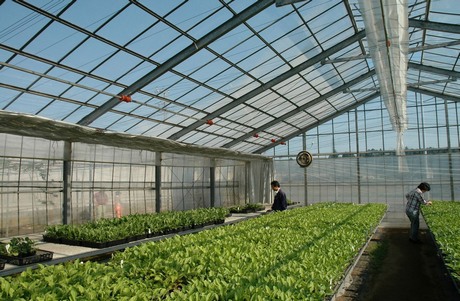
Sudlac is one of the few suppliers who manufactures these high-end horticultural paints. The company has three kinds of advanced products available for high-end horticulture: Eclipse LD, TransPAR and OptiFuse; all three products with their own characteristic features and all developed for a specific purpose. They can all be removed with the same cleaner: Topclear.
Eclipse LD
Eclipse LD is used to tint glass, plastic and polycarbonate greenhouses to regulate the light intensisty and humidity in the greenhouse for a better climate. Eclipse LD is a white wash and a perfect solution to lower the temperatures and protects the plants from too much light and heat. The intensity of the shading depends on the dilution of the product. It will stay on the greenhouse during the entire seasons and needs to be removed with the special developed cleaner Topclear. "It is an advanced product, for the growers that want to be in total control, hence it is not a perfect solution for growers who are looking for a solution to shade their greenhouse temporarily without cleaning. For them we have Eclipse F4 available, a paint that gradually deteriorates over time instead of wears in time and depending on the region, lasts between 3-5 months”, said Schouten.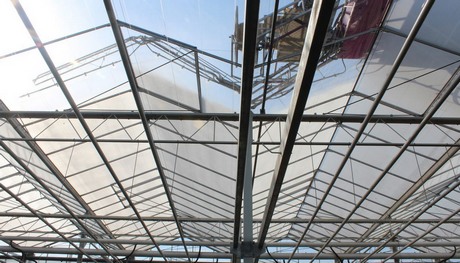
TransPAR
TransPAR is a transparent coating that enables a better crop growth by decreasing the temperature in the greenhouse without losing valuable growth light (PAR = Photosynthetically Active Radiation) and thus photosynthesis. The coating reflect the Near Infrared Radiation (NIR = Heat radiation), but still allows PAR light to enter the greenhouse. PAR light is used in the process of photosynthesis. "TransPAR is very popular by growers of some ornamentals, flowers and vegetables, because it decreases the temperatures but at the same time is very transparent so you do not lose too as much light as with a regular white shading product. Roughly speaking you can obtain the same temperature reduction as with a white wash, but with 25% more light!"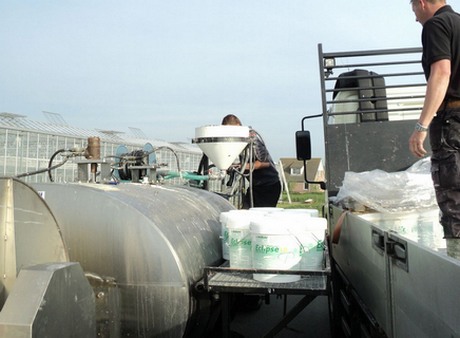
OPTIFuse
In the last couple of years the use of diffuse materials has gained popularity in horticulture. Growers in The Netherlands were one of the first growers to install the more expensive diffuse glass on their greenhouses and many research and discussions have passed the revue since then. Diffuse light distribution in the greenhouse will lead towards a better production because it generates a more equal climate, a better horizontal and vertical light distribution. For the growers that also want to take advantage of the characteristics of diffuse light but that do not want to refit their greenhouse with expensive glass, Sudlac's OptiFuse coating is a solution.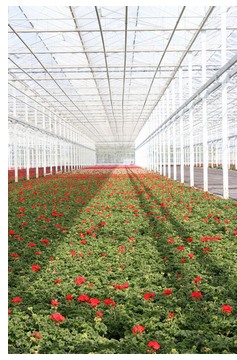 "Optifuse is one of our latest innovations, it is a removable coating that enables maximum light transmission and light diffusion", said Jorien. "The coating enables you to profit from all the available light. It diverts the light to the lower leaves, which is very interesting for more elongated crops such as tomatoes, sweet peppers and cucumbers. Especially for tomato growers that interplant, we see a dramatic improvement of the young plants after only a few weeks. But also orchid growers that normally apply multiple layers of white wash during the season, profit from higher light levels when starting with a first layer of Optifuse instead of a regular white shading paint. We are also very proud on the fact that we see perfect results when cleaning with Topclear, which is a very sensible and important point in the Netherlands.”
"Optifuse is one of our latest innovations, it is a removable coating that enables maximum light transmission and light diffusion", said Jorien. "The coating enables you to profit from all the available light. It diverts the light to the lower leaves, which is very interesting for more elongated crops such as tomatoes, sweet peppers and cucumbers. Especially for tomato growers that interplant, we see a dramatic improvement of the young plants after only a few weeks. But also orchid growers that normally apply multiple layers of white wash during the season, profit from higher light levels when starting with a first layer of Optifuse instead of a regular white shading paint. We are also very proud on the fact that we see perfect results when cleaning with Topclear, which is a very sensible and important point in the Netherlands.”According to Jorien Schouten, growers in important greenhouse horticulture areas are becoming more familiar with the advanced coatings. "Besides our home market France, we are active in the foremost European countries for horticulture like The Netherlands, Germany, Spain, Italy and Portugal. Oversees we are present in Japan, Australia and Africa and more recently we are present in Canada and Mexico via local distributors."
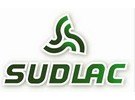 For more information:
For more information:Sudlac
Jorien Schouten
[email protected]
www.sudlac.com










